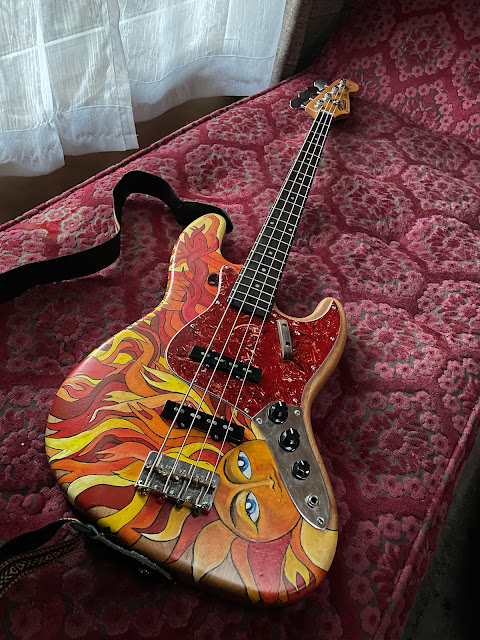Voormann Jazz Bass 2022
Klaus Voormann’s hand painted Precision Bass was the inspiration for this Jazz Bass.
The neck was a heavily worked over Chinese-made aftermarket jazz neck that, even after getting it to feel and look “like butter,” wasn’t quite the match with what was my BLUBOY Jazz (a heavily relic’d light blue bass that did find the right neck). The body was a blem alder badly-relic’d Seafoam/Surf green from Allen Eden Guitars. Their wood is always great, so I ordered the discounted body, slapped this neck on it with a set of Custom Shop Fender Jazz Bass pickups, and it actually sounded and played great.
But I just couldn’t live with the color, nor the bad scratch job inflicted on it to cheaply relic it. I still had an admiration for bassist/artist Klaus Voormann’s famous self-painted Precision Bass, and even built and painted a personalized version of a similar Precision last year, inspired by a Facebook post of someone else’s hand painted 60’s bass with King Crimson’s sun face - mine has The Mayor himself, HR PUFNSTUFF.
With another great playing and sounding bass that badly needed a reface, I decided to research Klaus’ design a bit more. On the entire internet I could only find 3 photos: a small B/W shot of him playing it, a good color one of him holding it (but with his right hand covering part of it), and a more contemporary photo with most of the painted design worn off from years of playing (I’m guessing he didn’t seal it). His was an Ash P, but whatevs.
My version, an Alder Jazz, copies his design as much as possible, with some adjustment for the different geometry and pickguard design, plus making up the mystery bits while maintaining his style. With a can of clear satin enamel over the acrylic design to hopefully help it not wear off (and I will admittedly never play this one bass as much nor as long as Klaus obviously played his) I now have a very pretty jazz bass with a very full and bright sound (with La Bella Strings stainless roundwounds, although I’m sure Klaus used flats along with the foam under the strings at the bridge to cut the high end and give it more thump).
Of course, since "finishing" this bass, I realize I have a photo that shows the back with the additional painting work, so I still might break out the paints for a touch up.



















































